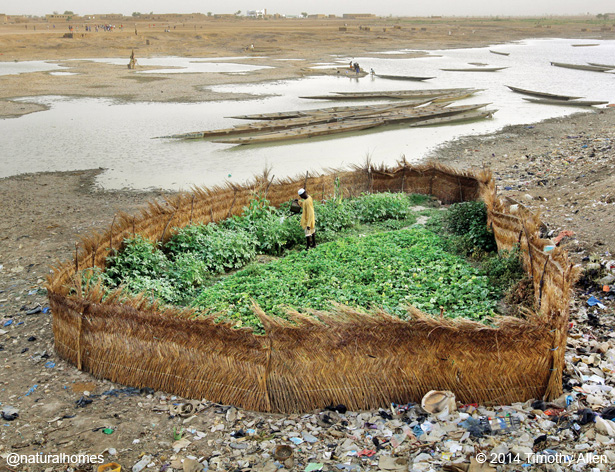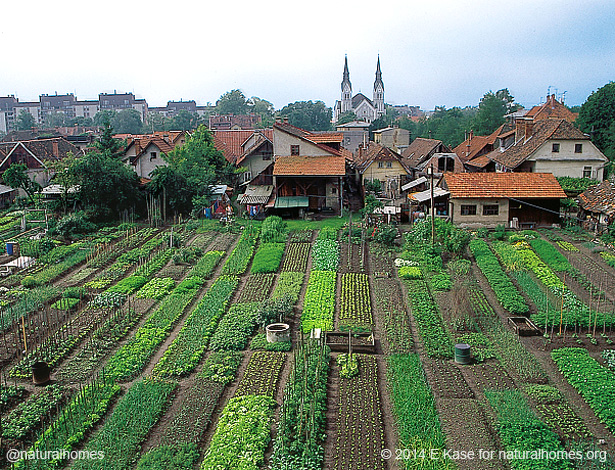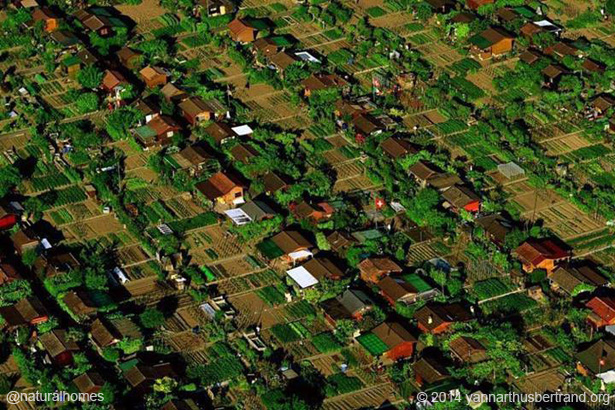Pattern No.177 Vegetable Garden; inspiration from eight
countries.
"In a healthy town every family can
grow vegetables for itself. The time is past to think of this as a
hobby for enthusiasts; it is a fundamental part of human life."
So said Alexander the author of 'A Pattern Language', 253 patterns
that define how we live.
In pattern No.177 he recommends that you, "Set aside
one piece of land either in the private garden or on common land
as a vegetable garden. About one-tenth of an acre is needed for
each family of four. Make sure the vegetable garden is in a sunny
place and central to all the households it serves. Fence it in and
build a small storage shed for gardening tools beside it."
|
|
|
|
|
| |
|
|
| |
|
Yuanyang,
China ... The Chinese have been
cultivating rice for at least 8,000 years. These hill slopes
of Yuanyang County plunge nearly 2,000m (6,500ft) to the
valley floor. Each contains thousands of stacked terraces
carved out by hand using basic digging tools (see video). |
|
|
| |
The rice terraces of China. Select the video button
above.
|
|
|
|
|
|
|
|
|
|
|
|
Terraced paddies like these are found across much
of southern China. A vast landscape dominated by rice cultivation. The people that live here,
the Miao,
have developed a remarkable rice culture, with every inch of
fertile land used to cultivate rice. Their wooden houses are built
on stilts on the steepest and least productive hillsides [Pattern
No.104]. Planting the rice
at the right time is critical to the success of the crop. The
ideal date isn't easy to predict. Most Miao homes look out over
the rice terraces and from early spring a window is left open to
let the red-rumped swallows nest on the ceiling of the house. Each
year elders note the exact day the swallows return and use the
birds' arrival to predict the best time to plant the rice. |
|
|
|
|
|
|
|
|
|
|
|
|
|
|
Djenné,
Mali ... During the dry season
the Bani River at Djenné shrinks back and exposes a mass of
litter and debris thrown away by its 33,000 inhabitants. The
town's population use mud from the river to build
and maintain their
adobe homes and Mosque. Mali is one of the world’s poorest
countries, where 44% of the population has no access to clean
water with widespread food shortages in the country,
particularly in the north.
Around
80% of Malians rely on agriculture for
survival. The farmer pictured right created a little paradise taking advantage of the damp Bani
riverbed and nearby water to grow his crops. It's likely he's
growing herbs and cassava. Cassava can be used
as a
starch to bind clay. |
|
 |
|
|
|
|
|
|
|
|
|
|
|
|
|
|
Ljubljana, Slovenia ... You might have seen this beautiful picture of
the Krakovo gardens. Like the allotment gardens of Geneva
below, they are right in the middle of a major city, in this
case Ljubljana in Slovenia. If you have seen the picture it's
probably as an example of permaculture practices or on a
travel website showing the sights of Ljubljana.
BUT...
the picture was taken over 30 years ago and sadly, in
later years, the
1.8ha (4.5 acres) of gardens became almost entirely
abandoned. Around twenty years ago the Krakovo gardens were an
important source of fresh vegetable for people of Ljubljana.
Shopping in Ljubljana's green market on a Saturday morning was
a community experience where people bought fresh organic food
grown within a stone's throw of where they lived. It was so
called 'economic prosperity' that brought the demise of the
gardens which you can see here on
Google Maps.
It is likely that there are many food producing plots or
gardens in urban areas that are facing the same challenge. |
|
 |
|
|
|
|
|
|
|
|
|
Food production always leaves behind a
cultural footprint that should be cherished and preserved.
Luckily the Krakovo gardens
are protected by law as a cultural heritage site since their
creation around 1774 and a local
community gardening project is working to bring them back
in to productive use. Now local, fresh, organic food is
available once more in the city. |
|
|
|
|
|
|
|
|
|
Geneva,
Switzerland ... |
|
|
|
 |
|
|
Pictured right are the allotment gardens of Av. de Crozet about 2km
from the centre of Geneva, Switzerland. The founder of these
types of gardens in Europe was a 19th century German physician
called
Moritz Schreber. In the German speaking countries these
allotment gardens are still called Schrebergarten [Schreber
gardens].
The idea of organised allotment gardening reached
a first peak after 1864, when Schreber started the 'Schreber
Movement' in Leipzig where areas within the city were made
available for children to play in a healthy environment in harmony
with nature. Later on these areas included gardens for children,
but soon adults began to cultivate them. This kind of gardening
later became popular in other European countries such as Austria
and Switzerland.
You can see the urban life around the picture
(right) when you zoom out here in
Google Maps.
The gardens are not, as many websites would have you believe, a
community of homes devoted to natural living. |
|
 |
|
|
|
|
|
|
|
|
|
|
In some countries the right to grow your own food is protected by
the law. In 2003, the Russian government signed the
Private Garden Plot Act into law, entitling citizens to
private plots of land for free. These plots range from 0.89
hectares to 2.75 hectares.
Russians have something built into their DNA that
creates the desire to grow their own food. It's not just a hobby
but a massive contribution to Russia's agriculture.
Read about the
dacha gardeners of Russia where In 2011, 51% of Russia's food
was grown either by dacha communities (40%) or peasant farmers
(11%) leaving the rest (49%) of production to the large
agricultural enterprises. More living
garden homes ...
|
|
| |
Russia's dacha and gardens. Select the video button
above.
|
|
|
|
|
|
|
|
|
|
|
|
|
|
|
Havana, Cuba ...
Food sovereignty puts the
people who produce, distribute and eat food at the centre
of decisions about food production and policy rather than
corporations and market institutions that have come to dominate
the global food system. In Havana, Cuba 90% of the
city's fresh produce comes from local urban farms and gardens
called Organopónicos.
Find out more about Havana's Organopónicos in the video
right [in Cuban Spanish with English subtitles].
The Cuban model of sustainable agriculture is looked upon as a
leading example of how to grow food without fossil fuels. After
the collapse of the Soviet Union Cuba experienced a artificial
peak oil crisis. Some of the agricultural changes involved using
more manual labour and animals instead of machinery. Organic
farming methods eliminated oil based fertilizers and pesticides.
|
|
| |
The allotments of central Havana, Cuba. Select the video button
above.
|
|
|
|
|
|
|
|
|
|
|
|
 |
|
|
Idaho,
USA ...
This is
Diane
and Thom's
garden in their small two acre farm. It's filled with bush beans,
pole beans, winter squash, sweet corn, tomatoes and sunflowers.
In the USA most of the food eaten
comes from many miles away and the connection between the farmer
and the consumer is disappearing. In the USA between 2002 and 2007
over
4 million acres of farm land were lost to urban developments,
an area nearly the size of Massachusetts. Diane and Thom
educate people and about small scale
organic food production to encourage and help others to do the
same. Their garden is a hands-on classroom providing opportunities
for all ages to get involved with food production. |
|
| |
Certified organic gardening. Select the video button
above.
|
|
|
|
|
|
|
|
|
|
|
|
|
|
|
Belo Horizonte,
Brazil ...
Brazil’s fourth largest city, Belo Horizonte, declared that
food was a right of citizenship and started working to make good
food available to everyone. One of its programs puts local farm
produce into all school meals. Their
food security programme was first
implemented in 1993. In 2004 the programme became a role model for
Brazil's national strategy in the fight against hunger.
In 2006
Belo Horizonte issued a law that requires schools to use at least 30% of their
fresh food from local growers. The city invests about 2% of its
budget in community food sovereignty programmes that
address health, social equality, job creation, diversified
agriculture, and local food production. |
|
| |
Groundbreaking food policy: Belo Horizonte. Select the video button
above.
|
|
|
|
|
England ...
Recently it was thought that the allotment gardens of England
were under threat. The Government's Communities Secretary was
thought to be examining plans to free
local authorities from a 106 year old obligation to provide plots
of public land for cultivation by gardeners. An official
government petition was launched for resident in the UK [see
protect the allotments of England] but happily signatories of
the petition have been assured that allotments in the UK are still
protected by law with a reference to these minutes of meeting at
the
House of Commons. |
|